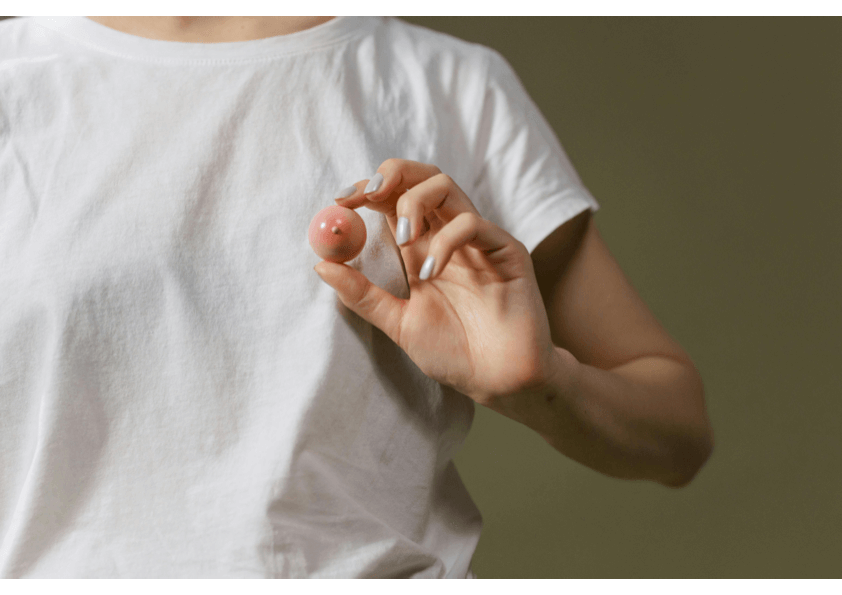Breast Self-Exam: How to Check Your Breast for Lumps
Breast cancer is the most diagnosed type of cancer globally, mainly affecting women, and it is crucial to learn how to check your breast for lumps for early detection and timely treatment. In this article, you will learn the importance of breast self-exam and breast awareness, as well as how to check your breast for lumps. It will also look at detecting early signs of cancer and the role of breast examination in detecting and preventing cancer.

Breast Cancer Awareness: The Importance of Breast Self-Exams
Breast cancer is a disease characterised by the abnormal growth of breast cells leading to the formation of tumours. This condition can be life-threatening if untreated, as the lumps can spread from one breast to the other, or even to the rest of the body. Therefore, the critical factor for successful cancer treatment lies in early detection, and breast self-exams play an essential role in this regard.
By performing the tests, you will understand the normal appearance and feel of your breasts. Thus, you can quickly notice and report any slight change or abnormality to your doctor for a proper, timely diagnosis. As a result, the physician can detect the disease during the early stages when it is treatable. Changes in your breasts may result from various conditions and not necessarily cancer. However, many women have reported having cancer after discovering a lump during a breast self-exam.
‘Check Your Breasts’
As mentioned above, not all lumps or changes in your breasts are a sign of breast cancer. But, it is essential to remember that early detection enables you to seek medical assistance quickly, leading to early diagnosis. Therefore, being proactive about your breast health can help increase your chance of improved treatment outcomes. Ensure you examine your breasts regularly to be in constant knowledge of your breast health.
Staying Breast Aware: Signs, Symptoms, and Self-Exams Demystified
Breast cancer has increasingly become a great concern for many people. Thus, it is crucial to understand the early symptoms, how to perform the breast self-exam and general breast health. Find a detailed discussion of the signs and symptoms of breast cancer and self-exam procedures below.
Signs and Symptoms of Breast Cancer
Some of the common breast cancer signs include:
- Thickening or lumps: a swelling or lump in the breasts or underarms is one of the most noticeable indications of breast cancer. Remember, not all growths necessarily indicate the presence of cancer; some may be benign (non-cancerous).
- Changes in breast size or shape: you should take any unusual alteration in the shape or size of your breasts seriously.
- Nipple abnormalities: nipple inversion and variation in texture like scaliness, ulceration, redness, or strange discharge (that isn’t milk) can be worrisome signs.
- Pain in the breast or nipple: although breast cancer rarely inflicts pain, you should report any unusual persistent nipple or breast discomfort to your doctor for evaluation.
- Skin changes: look out for any difference in appearance of your breast skin or nipples.
- Enlargement or swelling of the lymph nodes: the presence of swollen lymph nodes in your collarbone area or armpits could be an indication of spreading cancer cells.
The Right Self-Exam Procedures
Knowing how to carry out a self-exam is critical to staying breast-aware and taking care of your breast health. For successful self-exams, take into consideration the following:
- Understand your breasts: familiarise yourself with your breasts’ regular look and feel. Thus, you should know your breasts’ texture, size, and shape, including how they feel around your menstrual cycle.
- Please choose the appropriate time: it is best to check your breasts monthly at the same time, preferably a few days after the end of your menstrual period. During menstruation, your breasts are usually tender or swollen, and the results may be unreliable.
How to Perform a Proper Breast Self-Exam: A Step-by-Step Guide
Knowing the detailed procedure for performing a self-exam enables women to stay breast-aware, and will additionally help them detect early signs of breast cancer.
Visual Inspection
Start by taking off your shirt and bra, then stand upright in front of a mirror with your arms relaxing on your side. Check if your breasts are the usual shape, size, and colour. Note any difference in breast skin texture, size, shape, or noticeable swelling or nipple inversion to your doctor.
Raise Your Arms
Next, raise your hands above your head and press your palms together. Inspect your breasts again in the new posture and take note of any visible changes as above.
Examine Breasts While Lying Down
After doing a visual inspection, Proceed with a physical exam. Using a couch or bed, lie on your back with a pillow under your right shoulder and your left hand behind your head. Examine your left breast with your right hand.
Use the three middle finger pads to press and feel the whole breast and underarm, applying different pressure levels from light to medium and dense. Light pressure will let you feel the breast skin and tissue immediately underneath. You will feel the middle and deep breast tissue with medium and firm pressure.
To ensure you cover the entire breast, move your hand in a circular pattern, starting at the nipple and widening the circles as you progress. Alternatively, you can move in side-to-side or top-to-bottom motions.
Repeat on the Other Side
Then, reposition the pillow to your left shoulder, placing your right hand behind your head. Examine your right breast using your left hand, following the same steps as your left breast above. Consult your doctor if you find a lump during your inspection for further screening and guidance.
Check the Nipples
Squeeze your nipples gently and check for any strange discharge. As mentioned earlier, this could be a sign of cancer. Therefore, you should report any unusual breast secretion to your doctor for testing and diagnosis.
Examine While Standing or Sitting
Lastly, you can examine your breasts while seated or standing. You can also perform the exam in the shower if you find it easier with your skin wet.
Underarm Examination
Stand upright with your right hand relaxed on the hip. Use your left-hand palm to reach and feel your right armpit for lumps or swelling. Repeat the procedure on your left underarm.
Lump or No Lump: The Truth About Breast Self-Exams and Breast Cancer Risk
Breast self-exams are an essential tool for early detection and monitoring of breast cancer. However, several fears and misconceptions surround the self-exams. It is therefore essential to understand the significance of the exams even when you don’t detect any lumps.
Lumps Are the Only Symptom of Breast Cancer
One common misconception is that there is no need for self-exams if you feel no breast lumps. It is essential to understand that the purpose of breast self-exams is not only to detect tumours but also other changes in the breasts that may indicate potential issues. Moreover, not all breast cancers manifest as a lump. There are more signs and symptoms of breast cancer that are identifiable through these exams.
The Presence of Lumps Means You Have Cancer
Some individuals avoid examining their breasts, fearing they could find a tumour and that it could automatically mean they have cancer. Please remember that not all breast lumps are cancerous. Research shows that approximately 80% of breast lumps are benign. Therefore, breast inspection is a critical component of proactive breast healthcare. Besides, it is crucial to consult your doctor if you discover any abnormalities during the exam for a professional diagnosis.
Breast Self-Exams: Your First Line of Defense Against Breast Cancer
Breast examination is essential to early breast cancer detection and peace of mind. The significance of self examinations goes beyond cancer detection, and plays an important role in maintaining overall breast health.
- Early detection helps save lives: regularly checking your breasts can help detect breast cancer in its initial stages, improving the chances of effective treatment.
- Promotes awareness and empowerment: the examinations empower you to take charge of your breast health. Knowing what’s normal for your breasts enables you to identify any changes and take prompt action.
- Self-exams complement medical screenings:
although self-exams cannot replace medical screenings, they complement other cancer detection techniques. Screenings are a crucial component of routine check-ups and are recommendable. However, the exams allow for ongoing monitoring between your scheduled breast cancer screening appointments.
- Emotional well-being: routine breast exams can offer emotional reassurance and peace of mind by reducing anxiety and increasing confidence in your breast health.
Detecting Early Signs: Recognizing Breast Changes and Lumps
Understanding breast cancer signs and symptoms is critical for early diagnosis and prompt medical intervention. Some common symptoms include:
- Presence of mass or lumps in breast tissue: breast tumours are among the most common symptoms of breast cancer. However, having them doesn’t necessarily mean you have cancer; they could be benign cysts.
- Variations in breast shape or size:
changes including shrinkage, disproportion, or swelling of breasts can also be a sign of breast cancer. Also, any unusual changes in the breast skin texture require further examination.
- Nipple-linked changes:
changes related to nipples can also be indicators of breast cancer. You should seek the doctor’s advice immediately if you notice nipple inversion (turning inward) or unusual discharge (besides breast milk).
- Persistent, localised breast pain or tenderness: breast pain unrelated to menstruation can be another worrisome symptom of breast cancer. You should seek medical assistance and evaluation by your physician if you experience such pain.
Please remember that exhibiting any of these signs does not necessarily imply that you have breast cancer. However, you should immediately consult your primary care doctor if you notice these signs. Your doctor will conduct a proper medical examination and relevant breast cancer screening to help clarify your situation.
The Role of Breast Self-Exams in Early Detection and Prevention
Breast self-exam is a critical tool in combination with regular clinical exams and mammograms regarding early detection and prevention of cancer. Mammograms may be ineffective in women with dense breast tissue, and self-examining bridges the gap in aiding early detection in such cases.
Research shows that alongside routine clinical exams, breast self-exam can help reduce breast cancer mortality significantly. In the studies, self-exams helped detect more early-stage breast cancer than clinical exams only.
Moreover, by regularly examining your breasts, you become familiar with your breast health and stay vigilant. Thus, you are more likely to pursue medical assistance when you spot any breast changes leading to early diagnosis and improved chances of successful treatment.
Breast cancer is a global health concern affecting approximately one in every eight women. The symptoms include breast swellings, changes in the shape or size of the breast, dimpling, other skin abnormalities, or any variation in the nipples or unusual discharge. By performing regular breast inspections, you become familiar with your breasts’ usual feel and appearance. Thus, you can quickly notice any changes and seek further evaluation and screening to clear potential concerns. If diagnosed, you can access timely medical intervention, increasing the chances of successful treatment. Hopefully, this guide has helped you know how to check your breast for lumps and be breast-aware!
References
- BREASTS, WHEN TO EXAMINE YOUR. "Breast self-examination". Retrieved from http://www.losolivos-obgyn.com/_backup/info/medinfo/general_health/breast_care/breast_self_exam.pdf
- Sultania, M., Kataria, K., Srivastava, A., Misra, M. C., Parshad, R., Dhar, A., ... & Thulkar, S. (2017). Validation of different techniques in physical examination of breast. Indian Journal of Surgery, 79, 219-225. Retrieved from https://link.springer.com/article/10.1007/s12262-016-1470-5
- O'Malley, M. S., & Fletcher, S. W. (1987). Screening for breast cancer with breast self-examination: A critical review. JAMA, 257(16), 2196-2203. Retrieved from https://jamanetwork.com/journals/jama/article-abstract/365753

